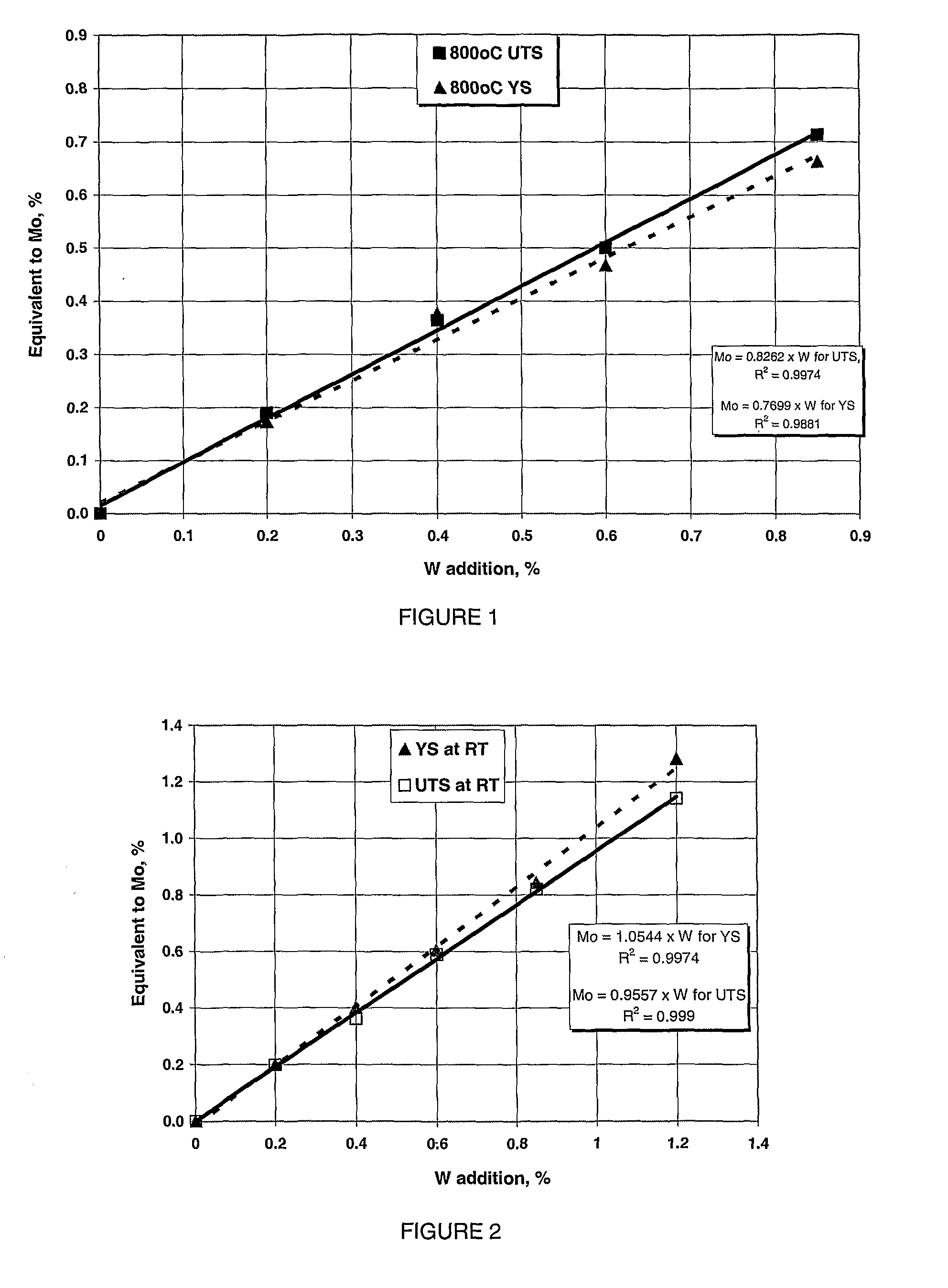Cast Iron With Improved High Temperature Properties
a high temperature, high oxidation rate technology, applied in the field of cast iron, can solve the problems of high oxidation rate at high temperature, increased oxidation resistance of cast iron in these applications, so as to improve hot oxidation resistance, improve ductility, and high strength
- Summary
- Abstract
- Description
- Claims
- Application Information
AI Technical Summary
Benefits of technology
Problems solved by technology
Method used
Image
Examples
example 14
[0041]A manifold for a 6.0 liter engine was cast from an iron composition containing 3.35% carbon, 3.99% silicon, 0.3% vanadium, 0.51% tungsten, with additions of Mg, Ce, rare earths and the remainder being iron plus impurities, all percentages being presented as percentages by weight. The microstructure displayed good nodularity (about 95%), nodule count of about 400 nodules / mm2, no pearlite and about 3% carbide. The carbide is blocky vanadium carbide and some tungsten-rich precipitate which is similar to the molybdenum-rich precipitate in the SiMo irons.
[0042]The manifold was evaluated in an engine exhaust simulation test. The test consisted of 1810 thermal cycles before failure. The test included heat shields applied with an exhaust gas temperature of 1616° F. (880° C). A thermal cycle consisted of a 6 minute heating portion with burners on followed by a 6 minute cooling period with burners off. During heating, the exhaust gas had a temperature of about 860-900° C. and portions o...
example 15
[0043]A manifold for a 6.0 liter engine was cast from an iron composition containing 3.45% carbon, 4.15% silicon, 0.43% tungsten, 0.41% molybdenum with additions of Mg, Ce, rare earths and the remainder being iron plus impurities, all percentages being presented as percentages by weight. The microstructure displayed good nodularity (approximately 94%), nodule count (approximately 350 nodules / mm2), 6 to 10% molybdenum-rich and tungsten-rich precipitates, very low pearlite levels (below 5%) and carbide (approximately 1%) levels.
[0044]The manifold was evaluated in an engine exhaust simulation test. The test consisted of 1790 thermal cycles prior to failure. This test included heat shields applied with an exhaust gas temperature of 1616° F. (880° C.). A thermal cycle consisted of a 6 minute heating portion with burners on followed by a 6 minute cooling period with burners off. During heating, the exhaust gas had a temperature of about 860-900° C. and portions of the surface of the manif...
example 16
[0045]A manifold for a 6.0 liter engine was cast from an iron composition exhibiting a hybrid / duplex graphite microstructure containing 3.15% C, 4.45% Si, and 0.85% Mo with additions of Mg, Ce, rare earths, and the remainder being iron plus impurities. This test included heat shields applied with an exhaust gas temperature of 1616° F. (880° C.). A thermal cycle consisted of a 6 minute heating portion with burners on followed by a 6 minute cooling period with burners off. During heating, the exhaust gas had a temperature of about 860-00° C. and portions of the surface of the manifold reached temperatures varying from 760° C. to around 780° C. After the burners are turned off, the exhaust gas and manifold cool down within a period of 4 or 5 minutes to a uniform temperature of about 70° C. The test consisted of 2012 thermal cycles prior to failure.
PUM
| Property | Measurement | Unit |
|---|---|---|
| wt. % | aaaaa | aaaaa |
| wt. % | aaaaa | aaaaa |
| temperatures | aaaaa | aaaaa |
Abstract
Description
Claims
Application Information
 Login to View More
Login to View More - R&D
- Intellectual Property
- Life Sciences
- Materials
- Tech Scout
- Unparalleled Data Quality
- Higher Quality Content
- 60% Fewer Hallucinations
Browse by: Latest US Patents, China's latest patents, Technical Efficacy Thesaurus, Application Domain, Technology Topic, Popular Technical Reports.
© 2025 PatSnap. All rights reserved.Legal|Privacy policy|Modern Slavery Act Transparency Statement|Sitemap|About US| Contact US: help@patsnap.com


